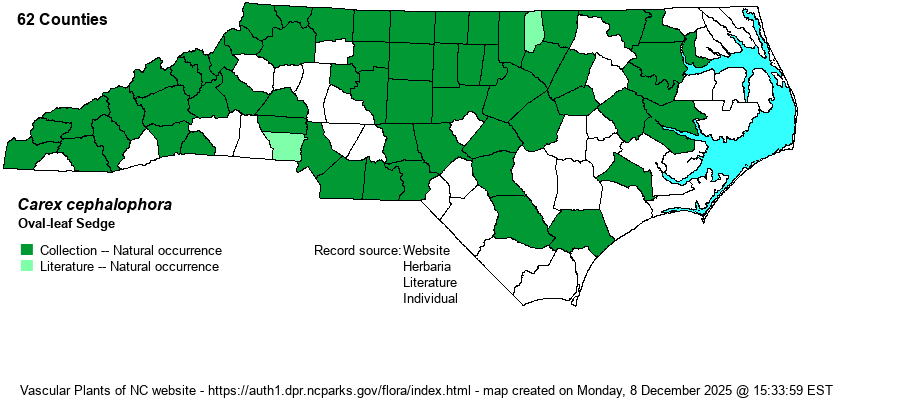| Author | Muhlenberg ex Willdenow | |
| Distribution | More-or-less throughout the state, but scarce in the outer Coastal Plain and in the southern portions of the Coastal Plain. Rare or absent from the Sandhills proper.
ME to MN south to northwestern FL and TX. | |
| Abundance | Fairly common to common in the Mountains and Piedmont; infrequent to locally fairly common in parts of the upper and central Coastal Plain. Very rare near the coast and in the Sandhills. | |
| Habitat | Mesic to dry-mesic hardwoods and pine-hardwood forests; often where oak-hickory dominate and often where rocky. | |
| Phenology | Flowering and fruiting May-July. | |
| Identification | All spikes are crowded at the summit of the flowering stem, forming an ovoid shape. Thus it is unlike C. muehlenbergii, which has a more elongate inflorescence. From C. leavenworthii it may be distinguished by longer perigynia teeth (0.3-0.5 mm vs. 0.1-0.3 mm) and broader leaf blades (2.5-5 mm vs. 1.1-3 mm). | |
| Taxonomic Comments | Belongs to the Phaestoglochin group (formerly Bracteosae), which usually requires careful exam of technical details to ensure identification.
The genus Carex is the largest in North America, and among the largest in the world. In temperate and boreal regions, Carex is often the dominant or co-dominant ground layer in many habitats. Seeds (achenes) are valuable food for birds and small mammals, while foliage is used by birds and mammals to make nests and as food by mammals. Species of Carex often look vastly different from one another -- spikes erect vs. drooping, tiny inflorescence vs. whopping, culms leafy vs. naked, perigynia beaked vs. beakless, stems densely bunched vs. single, etc. The genus has been divided into many sections (or groups), based on shared characters; some taxonomists have suggested that these be different genera, but that proves unworkable (so far). All Carex share the feature of a perigynium (an outer covering) which completely surrounds the achene (seed). This covering may fit tightly or loosely (like a small bladder), depending on which group or species. Details of perigynia shape, ornamentation, presence and size of beak, number of striations (or veins) are all important ID features. In recent years Rob Naczi and colleagues have stressed the importance of arrangement of perigynia -- whether spiral (3+ ranks) or distichous (2-ranked) -- and have named a number of new species as well as split off some older synonyms. Therefore, RAB's (1968) key, excellent for its time, can only be used in a general way today. Members of some sections of Carex are difficult to key out (notably Ovales, Laxiflorae, Griseae); this is in part due to variation among individuals of a species, or failings of the key. FNA has drawings of most species and some species may be found in two or more places within a key, to acount for variability. New species to NC, and new to science(!), continue to be found in NC. | |
| Other Common Name(s) | Capitate Sedge, Oval-headed Sedge, Short-headed Bracted Sedge. Exactly what "oval-leaf" means in relation to this species, which has typical linear leaves like all sedges, is unclear! The head is oval-shaped, and Oval-head Sedge seems to make more sense, though the most prevalent name is Oval-leaf Sedge. | |
| State Rank | S4 [S5] | |
| Global Rank | G5 | |
| State Status | | |
| US Status | | |
| USACE-agcp | FAC link |
| USACE-emp | FACU link |

